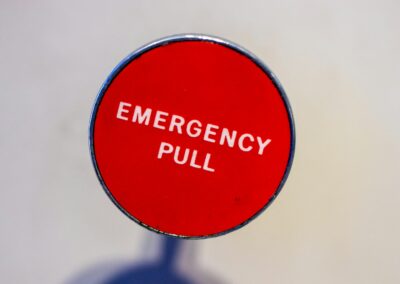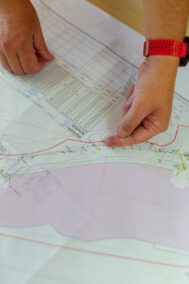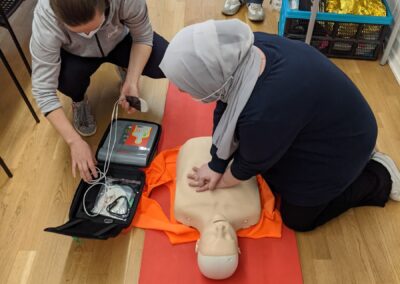How 5G Technology is Revolutionizing Emergency Response Teams
Introduction to 5G Communication in Emergency Response
The advent of 5G communication promises a transformative impact on various sectors, notably in emergency response systems. As cities like Riyadh and Dubai continue to modernize, integrating advanced communication technologies is crucial for enhancing public safety and efficient disaster management. The speed and reliability of 5G networks can significantly improve how emergency teams operate, making it a cornerstone for future urban safety strategies.
In emergency scenarios, every second counts. Traditional communication networks often face limitations such as congestion and latency, which can hinder timely responses. 5G technology addresses these issues by providing ultra-reliable, low-latency communication channels. This enhancement is particularly vital for emergency response teams who require immediate access to critical information and seamless coordination. The deployment of 5G in cities like Riyadh and Dubai is set to revolutionize their emergency services, setting a benchmark for global standards.
Moreover, the integration of 5G with other advanced technologies like Artificial Intelligence (AI) and the Internet of Things (IoT) further amplifies its potential. For instance, AI can analyze vast amounts of data in real-time, providing actionable insights to emergency responders. Simultaneously, IoT devices can offer continuous monitoring and instant alerts. Together, these technologies create a robust framework for an efficient and proactive emergency response system.
Benefits of 5G Communication for Emergency Teams
One of the most significant advantages of 5G communication for emergency response is its ability to facilitate real-time data sharing. High-speed networks enable the transmission of large files, such as high-definition videos from disaster sites, without delays. This capability allows command centers to assess situations more accurately and deploy resources more effectively. In bustling hubs like Dubai and Riyadh, where rapid urbanization demands advanced infrastructure, 5G ensures that emergency services can keep pace with the city’s growth and complexity.
Furthermore, 5G enhances the use of wearable technology and drones in emergency scenarios. Wearable devices equipped with 5G connectivity can monitor the health and location of first responders, ensuring their safety while in the field. Drones, on the other hand, can provide aerial views of disaster zones, offering a comprehensive perspective that ground teams might miss. These innovations, supported by 5G, significantly boost the operational efficiency and safety of emergency response teams.
In addition, 5G networks support the development and deployment of smart emergency vehicles. These vehicles, equipped with advanced communication systems, can function as mobile command centers. They enable field teams to access critical information, coordinate with other units, and make informed decisions swiftly. The implementation of such technology in Riyadh and Dubai not only enhances emergency response but also showcases these cities as pioneers in adopting cutting-edge solutions for public safety.
Challenges and Future Prospects of 5G in Emergency Response
While the benefits of 5G communication for emergency response are clear, several challenges need to be addressed to fully realize its potential. Infrastructure development is a primary concern, as the deployment of 5G networks requires significant investment and strategic planning. Ensuring comprehensive coverage, especially in remote and densely populated areas, is crucial for the effectiveness of 5G-enabled emergency systems.
Security is another critical aspect. As 5G networks handle vast amounts of sensitive data, protecting this information from cyber threats is paramount. Implementing robust cybersecurity measures is essential to safeguard the integrity and reliability of emergency communication systems. Cities like Dubai and Riyadh, with their focus on technological advancement, are likely to prioritize these measures to ensure the safe and effective use of 5G in public safety applications.
Looking ahead, the future of 5G in emergency response appears promising. Continued advancements in AI, IoT, and other complementary technologies will further enhance the capabilities of 5G networks. Collaborative efforts between government agencies, tech companies, and emergency services will be key to developing innovative solutions tailored to the unique needs of each city. In Saudi Arabia and the UAE, such collaborations can set new standards for emergency response, leveraging 5G to create safer and more resilient urban environments.
Conclusion: 5G as a Catalyst for Emergency Response Transformation
In conclusion, the implementation of 5G communication for emergency response marks a significant leap forward in public safety and disaster management. The unparalleled speed and reliability of 5G networks empower emergency teams with real-time information and seamless coordination, crucial for effective response efforts. As Riyadh and Dubai continue to embrace this technology, they set a precedent for other cities worldwide to follow.
The integration of 5G with advanced technologies like AI and IoT further amplifies its potential, creating a comprehensive and proactive emergency response framework. Wearable technology, drones, and smart emergency vehicles are just a few examples of how 5G can enhance operational efficiency and safety. However, addressing infrastructure and security challenges remains critical to fully harness the benefits of 5G.
As we look to the future, continued innovation and collaboration will drive the evolution of 5G-enabled emergency response systems. Saudi Arabia and the UAE, with their commitment to technological advancement and public safety, are poised to lead this transformation. By leveraging 5G, these nations can ensure that their cities are not only smart but also safe and resilient, ready to meet the challenges of the modern world.
Final Thoughts on 5G Communication for Emergency Response
The journey towards a fully 5G-enabled emergency response system is an ongoing process, filled with opportunities for innovation and improvement. For business executives, mid-level managers, and entrepreneurs, understanding the impact of 5G on public safety is crucial. Investing in technologies that support emergency services not only enhances community safety but also fosters trust and confidence among stakeholders.
Moreover, the successful implementation of 5G in emergency response can serve as a model for other sectors. The lessons learned and best practices developed can be applied to various industries, driving overall technological advancement and efficiency. As cities like Riyadh and Dubai continue to grow and evolve, their experiences with 5G will provide valuable insights for global adoption.
In summary, 5G communication for emergency response represents a transformative shift in how we approach public safety. By embracing this technology, we can build safer, more resilient communities, equipped to handle any emergency with speed and precision. The future of emergency response is here, and it is powered by 5G.
—
#5G #EmergencyResponse #PublicSafety #SmartCities #TechnologicalAdvancement #Riyadh #Dubai #AI #IoT #DisasterManagement
























